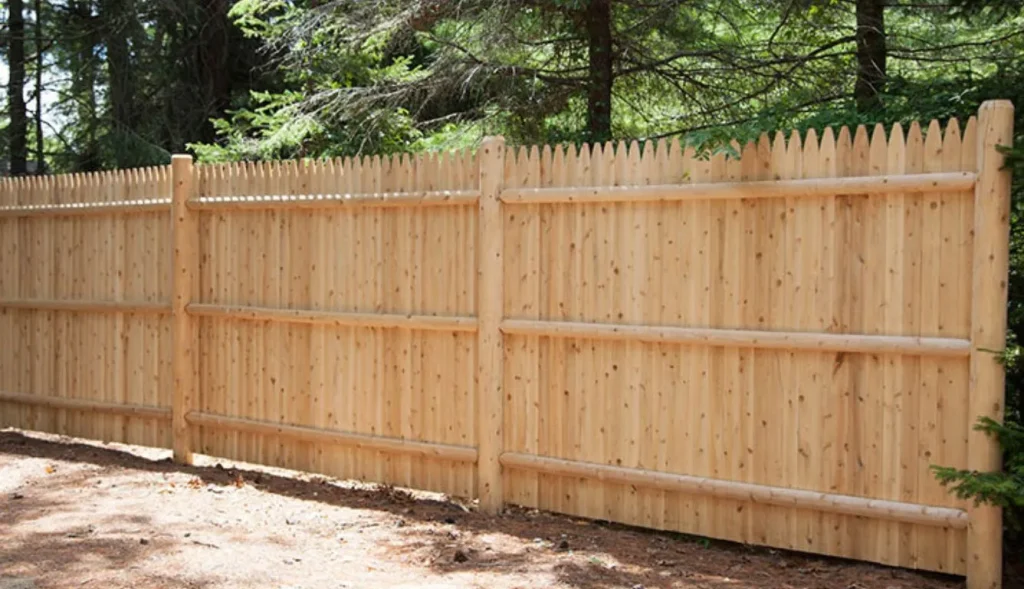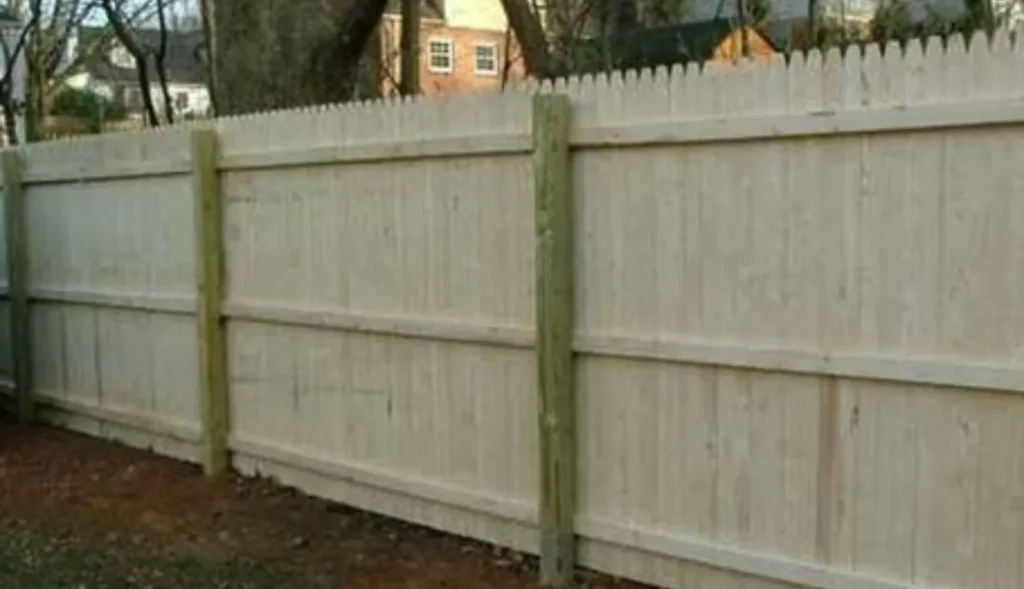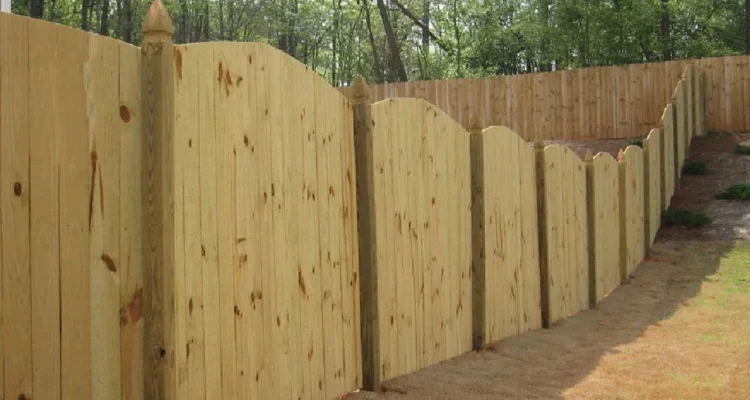Introduction
A stockade fence, with its classic and sturdy design, has been a staple in fencing for centuries. But what exactly is a stockade fence? In essence, it’s a type of fence made from closely spaced vertical wooden planks or posts. Often topped with a sharp edge or “palisade,” this style of fencing was historically used for both defensive and boundary purposes.

Brief History
Historically, stockade fences were crucial in fortifying settlements and protecting against intruders. Early settlers in America used them to secure their properties and establish boundaries. Today, while they might not be used for defense, they remain a popular choice for privacy and security in residential settings.
Types of Stockade Fences
Traditional Stockade Fence
The traditional stockade fence is characterized by its vertical wooden planks, often made from hardwoods like oak or cedar. These fences typically have a rustic appearance, reflecting their historical origins.
Modern Stockade Fence
Modern versions often use pressure-treated wood or composite materials. They might include features like smooth, rounded tops and more uniform spacing, giving them a cleaner and more contemporary look.
Variations in Design
From decorative scalloped tops to integrated gates and custom colors, stockade fences come in various designs to suit different tastes and needs.
Materials Used in Stockade Fences
Wood
Wood is the classic material for stockade fences. Its natural appearance and strength make it a favorite choice, although it requires regular maintenance to prevent rot and decay.
Composite Materials
Composite materials, which blend wood fibers with plastic, offer increased durability and reduced maintenance compared to traditional wood. They are resistant to insects and weather damage.
Vinyl
Vinyl stockade fences mimic the look of wood but offer even greater durability and ease of maintenance. They are impervious to moisture, insects, and do not require painting.
Advantages of Stockade Fences
Privacy
One of the biggest advantages of stockade fences is their ability to provide privacy. The closely spaced planks create a solid barrier that prevents outsiders from peeking into your yard.
Security
Stockade fences are also effective for security. Their height and solid construction make them a formidable barrier against intruders.
Aesthetic Appeal
With their classic design, stockade fences can enhance the visual appeal of your property. They can be customized to complement various architectural styles.
Disadvantages of Stockade Fences
Maintenance Requirements
Wooden stockade fences require regular maintenance, including staining and sealing, to prevent damage from the elements. Composite and vinyl options, while lower maintenance, are not entirely free from care.
Durability Concerns
Wooden fences can be prone to rot, warping, and insect damage over time. While composite and vinyl are more durable, they can still suffer from issues like fading or cracking.
Cost Considerations
Stockade fences can be expensive, particularly if you opt for high-quality materials or professional installation. It’s essential to factor in both initial costs and long-term upkeep.
Installation of a Stockade Fence
Preparing the Site
Before installation, clear the area of any debris or vegetation. Mark the location of the fence posts and ensure the ground is level.
Building the Frame
Construct a sturdy frame using treated wood or metal posts. The frame provides the foundation for the fence panels.
Erecting the Fence Panels
Attach the vertical panels to the frame. Ensure they are evenly spaced and securely fastened.
Securing the Fence
Reinforce the fence with additional supports or anchors as needed. Check for stability and make any necessary adjustments.
Maintenance Tips for Stockade Fences
Cleaning
Regularly clean your fence to remove dirt, mold, or algae. Use a mild detergent and a soft brush to avoid damaging the finish.
Repairing Damage
Inspect your fence for signs of damage, such as broken panels or loose posts. Repair or replace damaged sections promptly to prevent further issues.
Preventing Rot and Decay
For wooden fences, apply sealant or stain to protect against moisture. Composite and vinyl fences should be inspected for cracks or other damage.
Stockade Fences vs. Other Fence Types
Stockade vs. Picket Fences
Picket fences are typically shorter and have spaced slats, which offer less privacy but a more open feel. Stockade fences, in contrast, provide a solid barrier.
Stockade vs. Chain Link Fences
Chain link fences are less expensive and offer visibility but lack the privacy and aesthetic appeal of stockade fences.
Stockade vs. Vinyl Fences
Vinyl fences offer durability and low maintenance but may lack the traditional charm of wooden stockade fences.
Design Considerations
Height and Width
Consider the height and width of your fence based on your privacy needs and local regulations.
Finishing Options
Choose from various finishes, including paint, stain, or natural wood, to match your home’s style.
Customization
Add features like decorative toppers, gates, or lattice work to personalize your stockade fence.
Cost of Stockade Fences
Material Costs
The cost of materials varies based on the type of wood or composite used. Vinyl tends to be the most expensive option.
Installation Costs
Professional installation can add to the overall expense. DIY installation can save money but requires time and effort.
Long-Term Expenses
Factor in maintenance costs over the lifespan of the fence. Wooden fences generally require more upkeep than composite or vinyl options.
Legal and Regulatory Considerations
Local Building Codes
Check local building codes to ensure your fence complies with height and placement regulations.
Homeowner Association Rules
If you live in a community with a homeowner association, review their rules regarding fence installation.
Permitting Requirements
Obtain any necessary permits before beginning installation to avoid fines or legal issues.
Stockade Fence in Different Climates
Cold Climates
In colder regions, ensure your fence is treated to resist freezing temperatures and snow.
Hot Climates
For hot climates, choose materials that can withstand high temperatures and direct sunlight without warping.
Humid Climates
In humid areas, opt for materials that resist mold and mildew, and ensure proper ventilation to prevent decay.
Enhancing Your Stockade Fence
Adding Gates
Incorporate gates for accessibility while maintaining the fence’s security and privacy.
Incorporating Landscaping
Use landscaping elements like shrubs and flowers to complement and soften the appearance of your fence.
Decorative Elements
Consider adding decorative features such as post caps or finials for a unique touch.
Real-Life Examples and Case Studies
Residential Use
Explore how homeowners use stockade fences to create private outdoor spaces and secure their properties.
Commercial Use
Learn about stockade fences in commercial settings, including their use in securing business premises.
Unique Applications
Discover unique applications of stockade fences, such as in historical reenactments or themed events.
FAQs
What is the typical lifespan of a stockade fence?
A stockade fence typically lasts 15-20 years, depending on the material and maintenance. Wood fences may have a shorter lifespan if not properly maintained.
Can I install a stockade fence myself?
Yes, installing a stockade fence yourself is possible with the right tools and skills. However, professional installation ensures proper construction and can save time.
How do I choose the right material for my stockade fence?
Consider factors like durability, maintenance, and cost when choosing a material. Wood offers traditional appeal, while composite and vinyl provide low maintenance.
Are stockade fences good for noise reduction?
Yes, stockade fences can help reduce noise due to their solid construction, making them effective in blocking sound from traffic or neighbors.
What are the most common problems with stockade fences?
Common issues include rot, insect damage, and warping in wooden fences, while composite and vinyl fences may experience fading or cracking.

Conclusion
In summary, a stockade fence is a versatile and historically rich option for those seeking privacy and security. Whether you opt for traditional wood or modern materials, understanding the various aspects of stockade fences can help you make an informed decision. From installation and maintenance to cost and design, a well-chosen stockade fence can enhance the functionality and appearance of your property.


Congratulation!